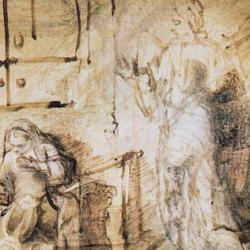Flood stories are widespread in the ancient world, and many studies compare the Babylonian account with the best known account, that of Noah in Genesis. Y.S. Chen’s The Primeval Flood Catastrophe, a revision of the author’s DPhil dissertation, looks at flood traditions from another angle, attempting to trace the development of the Mesopotamian flood tradition prior to its best-known instantiation in Gilgamesh and Atrahasis.
Chen justifies a fresh study of this well-trodden terrain by pointing to the wealth of new documentation: “with the increasing, even overwhelming, amount of relevant Mesopotamian sources that have come down to us from the Early Dynastic III period (c. 2600-2350 BC) to the first center BC, studies on the Flood traditions continue to represent a promising and fertile field of research. Sumerian and Akkadian flood terms are found not only in mythological narratives and chronological texts, but also in divine and royal hymns, royal inscriptions, didactic literature, disputations, administrative documents, administrative and literary letters, astrological and astronomical texts, incantations and magical texts, lexical texts, and literary catalogues. . . . The abundance, diversity, complexity, and particularity of the textual evidence from a wide historical span on the Mesopotamian side necessitate that the Mesopotamian flood traditions must be studied in their own right before they may be used for comparison with the biblical and other cultural traditions” (2).
He concludes that “Mesopotamian traditions related to the Flood only emerged from the Old Babylonian period onwards,” and argues that, though the myths reflect the “hydrological conditions of lower Mesopotamia,” they are cultural constructs “forged in particular socio-political contexts,” traditions “invented” in contexts that he attempts to account for (254).
Looking carefully at the differences between various accounts, for instance, helps him to locate a shift from the Old Babylonian version of Gilgamesh, which emphasized the individual pursuit of eternal life, to later versions that express “a broader concern for civilization or society as a whole,” evident especially in an inserted section on royal duties (181). Similarly, “the exaltation of the ancient city of Uruk in both the prologue and epilogue also signifies that what had enduring value did not lie somewhere far away . . . but right at home in Gilgames’s own city. As valuable as it was, the city had been neglected due to his search for fame and immortality.” Gilgamesh is not presented as an ideal king in the late version, but he comes to recognize the value of kingship through the wisdom gained by his “waywardness, striving, and disillusion” (182).
One might be dubious that we can reconstruct the socio-political circumstances for an Old Babylonian composition. Strike that: I am dubious. But Chen’s learned, cautious, detailed study makes as plausible a case as one can likely hope for.















